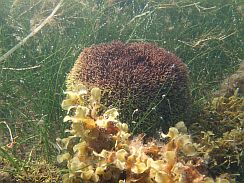BACOSA II
The research project „BACOSA II“ aims at an improvement of water quality in shallow lagoons along the German Baltic Sea coast.
Information in German: Pressemitteilung der Universität
Projekt BACOSA (Baltic Coastal System Analysis and Status Evaluation)

BACOSA is a joint project between the universities of Rostock, Greifswald, and Kiel. The aim is to investigate and quantify the material flows in macrophyte-covered shallow water ecosystems. Field studies are taking place at different locations along the German east coast. The main focus is on the complex interactions between vegetation, sediment, nutrients, phytoplankton and zooplankton as well as wind and wave induced water movements in gradients from the reed belt to stocks with submerged vegetation to the open water. The data obtained are used to get more detailed insights into the functioning of shallow water ecosystems.
Among 5 subprojects, project 2 is located at the Biological Station Hiddensee of the University of Greifswald. The study investigates interactions between submerged macrophytes and various abiotic and biotic parameters in water and sediment. In 2013 the investigations were carried out at two locations in the lagoon Vitter Bodden, located east of Hiddensee, supported by four diploma students. At both sites, areas with dense or sparse vegetation were marked. In the course of the year, macrophytes, nutrient concentrations, phytoplankton and zooplankton levels as well as the content of suspended material in the water column were quantified. The sediment was characterized, and the light attanuation by the water was measured. Wind data supplemented the measurements. In addition, methodological experiments were carried out on the one hand to measure water movements near the sediment (mainly turbulence) with a 3D flow probe, and on the other hand to determine sedimentation rates by means of various sediment traps. This study program was carried out at other locations along the German east coast along with the other subprojects.
In 2014, two locations in the chain like lagoon Darß-Zingster Bodden will be examined together with all other subprojects in the course of the year. The data will be included in an assessment of ecosystem services of the Darß-Zingster Bodden.
Stoneworts (Characeae)
We investigate ecological and taxonomic aspects as well as topics related to nature conservation. Both in freshwater and brackish water, stoneworts are especially sensitive against eutrophication.
We investigate ecological and taxonomic aspects as well as topics related to nature conservation. Both in freshwater and brackish water, stoneworts are especially sensitive against eutrophication. Consequently, a high share of charophyte species are threatened both in Germany and in other countries.
Project Flora Hiddensee
A data collection about historical and actual occurrences of higher plants was started by Prof. A. Helbig, Vogelwarte Hiddensee (†) and Dr. H. Hübel, Biologische Station Hiddensee (†). For a future “Flora of the island of Hiddensee”, we collect data on higher plants on the island of Hiddensee. Please take contact if you find rare plants on Hiddensee, or if you observe plants not included in the List of higher plants on the island of Hiddensee [list as PDF (edition 2010, in German)]
